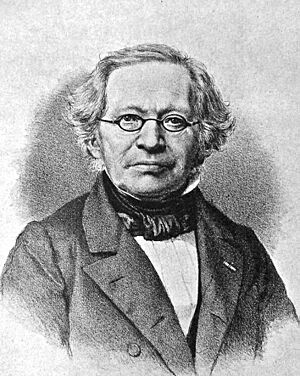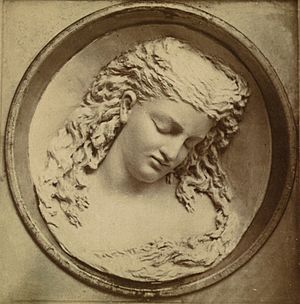Henrik Hertz facts for kids
Quick facts for kids
Henrik Hertz
|
|
|---|---|
 |
|
| Born | 25 August 1797 Copenhagen |
| Died | 25 February 1870 (aged 72) Copenhagen |
Henrik Hertz (born August 25, 1797 – died February 25, 1870) was a famous Danish poet. He wrote many plays and poems that became very popular.
Contents
About Henrik Hertz
Henrik Hertz was born in Copenhagen, Denmark. His family was Jewish. When he was very young, his father passed away. The family also lost their home during the bombardment of 1807. This was when Copenhagen was attacked with bombs. A relative named Mendel Levin Nathanson, who was a well-known newspaper editor, helped raise young Henrik.
Early Life and Education
In 1817, Henrik Hertz started studying at the University of Copenhagen. He finished his law exams in 1825. Even though he studied law, he loved literature the most. He spent some time living in the South of France.
First Plays and Secret Writings
Henrik Hertz began his writing career with plays. In 1826 and 1827, two of his plays were shown: Hr. Burchardt og hans Familie (Mr. Burchardt and his Family) and Kjærlighed og Politi (Love and Policy). In 1828, he wrote the comedy Flyttedagen (Moving Day).
In 1830, he created something new for Danish theater. It was a comedy written in rhyming poetry called Amors Genistreger (Cupid's Strokes of Genius).
That same year, Hertz published a book called Gjengangerbrevene (Letters from a Ghost). He published it without using his name. He pretended the letters were written by another poet, Jens Immanuel Baggesen, who had died. The book was a funny and smart defense of another writer, Johan Ludvig Heiberg. It was a huge success, but Henrik Hertz kept his secret for many years.
Travels and More Works
In 1832, Hertz published a teaching poem called Naturen og Kunsten (Nature and Art). He also wrote Four Poetical Epistles. His next comedy was En Dag paa Øen Als (A Day on the Island of Als). This was followed by Den eneste Fejl (The Only Fault) in 1835.
In 1833, Hertz traveled through Germany and Switzerland to Italy. He spent the winter there, enjoying the warm weather and beautiful scenery. He returned to Denmark the next autumn, traveling through France.

Later Successes and Famous Plays
In 1836, his comedy Sparekassen (The Savings Bank) was very popular. But his biggest success came in 1837 with Svend Dyrings Huus (Svend Dyring's House). This was a beautiful and original play about Danish history and legends.
His historical play Valdemar Atterdag (Valdemar IV) in 1839 was not as well-received. However, in 1845, he had another huge success with his play Kong Renés Datter (King René's Daughter). This play became famous worldwide. It was translated into many languages. The famous composer Tchaikovsky even turned it into his opera called Iolanta. The play tells a romantic story about Yolande, Duchess of Lorraine.
After this, he wrote the play Ninon in 1848, the romantic comedy Tonietta in 1849, Et Offer (A Sacrifice) in 1853, and Den yngste (The Youngest) in 1854.
Later Years and Legacy
Henrik Hertz also published collections of his lyrical poems in 1832, 1840, and 1844. From 1858 to 1859, he was the editor of a literary magazine called Ugentlige Blader (Weekly Pages). His last play, Tre Dage i Padua (Three Days in Padua), was performed in 1869. He passed away on February 25, 1870.
Henrik Hertz is known as one of Denmark's most important poets. His poems are full of vivid descriptions and strong feelings. He was very skilled at writing verses. His style was graceful and charming. He was also a very original writer of romantic plays. His plays Svend Dyrings Huus and King René's Datter are still considered classics in Danish theater. He often wrote about the beautiful scenery and strong emotions of warmer, southern places.
His collected Dramatic Works were published in 18 volumes between 1854 and 1873. His Poems were published in 4 volumes from 1851 to 1862.

